
For Atlas Obscura, the reader journey begins on the web and ends at The Great Wall of China, a Southern California mining cave, or even a pigeon museum in Oklahoma City.
The locations are a few of the 150 places Atlas Obscura readers will visit as part of Obscura Day, the site’s annual event dedicated to the world’s most unique and unusual locations. The event, which will take place in 39 states and across six continents, is focused on building real-world communities around the site’s digital audience, which now sits at roughly 3 million unique visitors a month, five times a year ago according to comScore. The site ran over 250 events in 2015 alone.
“Our mission is to give everyone the feeling the world is a big, surprising place, and we want to help them experience it,” said David Plotz, CEO of Atlas Obscura and former editor of Slate. “And these are experiences we want people to have in the real world, not just digitally.”
While many publishers are looking to events as a way to shore up their businesses in the face of dwindling display ad revenue, the idea of engaging readers is core to the Atlas Obscura approach, particularly on the web. One of the site’s main attractions is the Atlas, a compendium of over 9,000 locations sourced in large part from Atlas Obscura readers. Over 25,000 people have contributed to Atlas so far, with 110,000 people creating accounts to share places they’ve been to, or would like to visit. The rest of Atlas Obscura’s content comes from its seven-person editorial team, which also vets user contributions.
That kind of engagement is hard to come by these days. While many publishers have successfully harnessed Facebook to attract new readers, many still struggle with turning those flyby readers into actual engaged audiences. Atlas Obscura hopes its focus on community — both offline and online — will make it an exception. Another core part of the site’s real-world community are the local “societies” it’s built in Washington, San Francisco, Los Angeles, Philadelphia, New York, and Illinois. Each group is run by a combination of a local society lead and a handful of Atlas Obscura “field agents,” city locals who are in charge of finding and organizing trips to interesting locales with other society members.
The challenge, though, is turning that engagement into cash. While Atlas Obscura expects thousands to attend its Obscura Day events the year, the venture isn’t an especially significant moneymaker so far, Plotz said. The average walking tour, for example, attracts around 10 to 75 people, so they’re hard to scale. Instead, the events largely serve as what Plotz calls “grassroots marketing,” a way for Atlas Obscura to get its brand in front of new people and helps solidify its relationship with existing readers.
Where Atlas Obscura is successfully building a business is in its larger. more premium events. In February, it put together a sleepover at New York City’s Explorers Club, the private venue whose members have included famous explorers such as Neil Armstrong and Sir Edmund Hillary (the first man, with Tenzing Norgay, to summit Mt. Everest). Atlas Obscura made money on the event in two ways: Not only did a few dozen people pay $200 to attend, but the event also landed a sponsorship from mattress company Oso. “That kind of intensely engaged audience are the people brands want to reach,” Plotz said. “The events are a great differentiator for us.”
Still, in the short term, Atlas Obscura expects the bulk of its revenue to come from sponsored content and, to a lesser extent, banner ads. (The site’s relatively small audience means that it will be hard to build a significant display business.) Last year, the Illinois Office of Tourism sponsored stories that highlight interesting and unusual places in the state. Likewise, for a series sponsored by camera maker Olympus, Atlas Obscura hired professional photographers to create photo essays using the company’s equipment.
Ultimately, Atlas Obscura is betting that it will succeed with both readers and advertisers because it represents something universal, much like National Geographic captured the hearts and minds of would be explorers over the last 127 years. “Everyone loves that feeling of discovery and exploration. Not a single person doesn’t get a thrill from seeing something new and surprising,” Plotz said.